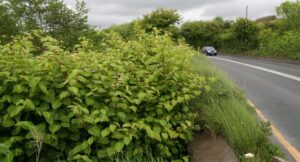Information and Advice
Invasive species threaten our native biodiversity, can cause havoc on the recreational value of an area and have negative economic consequences for local industries. They cost Europe around €10 billion annually. The total monetary impact for Ireland is not known. The Council is working to control Japanese knotweed and himalyan balsam (Camcor River catchment). Giant hogweed is not recorded in Offaly. There are two known and monitored locations of gunnera.
Japanese Knotweed in Offaly
Japanese knotweed is growing in Offaly – but hopefully with awareness and treatment it can be contained and minimised. Since 2009, records of all known locations have been collated and all relevant sections of the County Council have been made aware of the issues involved, particular the spread of Japanese knotweed by hedge and verge cutting and movement of soil. Since 2014, all known sites of public lands have been treated on an annual basis. Where practical owners of private sites have been notified if they have knotweed growing on their property.
Background
This menacing plant, introduced to Irish gardens in the 19th century as an exotic, has become one of Ireland’s 10 Most Unwanted Invasive Aliens. Able to grow a meter in less than a month, Japanese Knotweed can push through concrete and tarmac. Meanwhile, its roots can spread 7 meters wide and 5 meters deep depending on the soil structure. In no time at all, Japanese knotweed can create an impenetrable thicket 3m high.
Its unusually deep leaf litter smothers rival plants and wipes out native species. But even when it isn’t visible above ground, Japanese knotweed can lie dormant, but very much alive, below ground for up to a decade. Years after projects have taken place to remove Japanese Knotweed, it is not defeated, because it lies dormant underground hibernating and every year the area must be scoured for re-growth. Unless the plant is constantly monitored, the area will be covered in knotweed again in a number of years.
What does it look like?

In the summer Japanese Knotweed can reach over three meters in height. It has green shield shaped leaves and spikes of small, creamy white flowers in September. In the autumn it sheds its leaves and becomes an unattractive stand of dead, brown, hollow stalks. In the spring, little dark red shoots like dragons’ tails emerge. Growing up to 4 centimeters a day, they quickly form bamboo-like stems which sprout green leaves. Its roots are dark brown with a bright-orange inside which can snap easily, like a carrot.
Why is it a problem?
It beats native plants
Few plants introduced to Ireland are as invasive or destructive as Japanese knotweed. It can take over an area, wiping out all other plants—including our native species—in a single season. It does this by blocking out light and the deep leaf litter presents new growth of native plants.
It is destructive on building sites
The ability it has to grow through tarmac and concrete makes it a problem on a site where work is to be carried out. Unless comprehensive eradication work is done, Japanese Knotweed can disturb the site in the coming decades.
It is a hazard on the road side
On the road side, as it grows so quickly and so tall, it can block site lines.
How does it spread?
Without knowing it, people help Japanese Knotweed spread. Every Japanese Knotweed plant in Ireland is female. The only way it spreads is through its rhizomes or fragments of its own vegetation breaking off and re-growing. This means that when people cut it to try and get rid of it they actually help it to form new clumps. Strimming it is the worst thing you can do as it creates millions of tiny pieces, which can sprout into a new plant. Any growth cut or broken should be burnt. A real accelerator in recent years has been the moving of contaminated topsoil and building material around the during construction and road projects.
Lack of knowledge about how it spreads has meant that hedge cutting contractors have been cutting and spreading it unknowingly. Very often when there is a roadside area of knotweed, there are several clumps further down the road where sections from the flail cutter have landed in previous years. Offaly County Council’s hedge cutting notice asks landowners not to cut knotweed and to notify the Council of its location.
What can you do to stop this menace?
DON’T IGNORE IT. A small Japanese knotweed plant can quickly become a major infestation.
Do not strim, flail or chip it. Japanese knotweed can reproduce from tiny needle sized fragments of rhizome, twig or even leaf.
Notify Offaly County Council of any locations – If you think you have seen Japanese knotweed, or you’re not sure and need help with identification, call the heritage officer at 057-9346839 or email heritage@offalycoco.ie (preferably with an image).
September is best time to begin to take action – Spray and monitor identified clumps. Where you have a confirmed site, getting it treated in the second half of September means that as the plant dies back for the autumn, it will pull the herbicide down to its roots. This is the most effective time to spray. It will need continued attention and spot spraying to stop it re–emerging. Do NOT get it sprayed if you are near a watercourse. Stem injection systems are very effective but very time consuming.
Check sites are free from Japanese Knotweed before soil is moved. Because it is such a problem to control, it is particularly important not to let new sites establish and contaminated soil should not be moved without following correct licensing arrangements.
